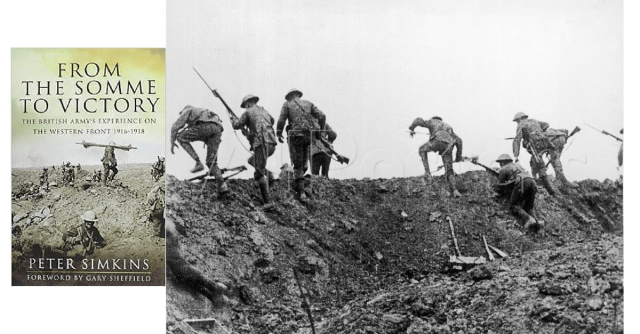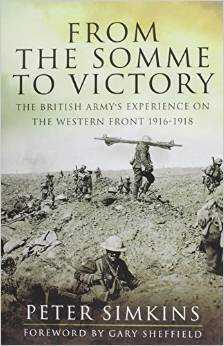Before I begin this review I feel that I have to admit that I know Peter Simkins. He was my MA supervisor at Birmingham University and I have the greatest of admiration for him as a historian and as a fine bloke.
This book, the long awaited sequel to his excellent Kitchener’s Armies The Raising Of The New Armies 1914 – 1916, is a masterful piece of work.It is a series of research questions and answers, or essays rather than a general history of the Great War. Peter Simkins uses statistical analysis to chart the operational status, achievements and ability and weaknesses of the British Army during the Somme Campaign and beyond to 1918. Although it does not cover all engagements or campaigns from 1916 to 1918.Arras, Messines, Passchendaele andCambrai are missing from this analysis whichallows scope for further work.
His literature review of all current historical work being done on the British Army in the Great War is extensive. Another chapter reviews past and current Great War historians, his evaluation of the Somme takes up three chapters. One chapter deals with V Corps and the recapture of Thiepval and the Ancre Heights in August 1918 and the final chapter is about the experience of the 12th Division in the Hundred Days Campaign. The endnotes and bibliography are second to none.
The BEF and the generals have been subject to a good deal of criticism from certain quarters since the Great War, some of which was deserved but much of which was based upon half-truths and propaganda. Therefore, I thoroughly enjoyed Chapter 6, “‘The Absolute Limit’ British Divisions at Villers-Bretonneux, 1918.” There is a tendency to view these engagements in April 1918 as purely ‘Aussie’ affairs. Indeed, the Australians’ experience of certain retreating British troops in the face of the German offensive caused them to despise the British soldiers and their commanders. Not all British units retreated at Villers-Bretonneux and they fought alongside the Australians with determination and vigour. However, that did not stop Monashfrom describing the Tommies as, “Bad troops, bad staffs, bad commanders.” Peter Simkins attacks this stance and seeks to review and re-examine the facts. I was not surprised to find that he found the Australian opinion of the time wanting and for me this is the best chapter in the book, not in the least because it is not about the Somme 1916 and because it is a fine piece of revisionist work.
Personally, I think that the 17th (Northern) Division was rather better than a ‘workman like’ unit but we can agree to differ on that score! This book is very useful for research and for reference, as well as being what I like to call a ‘good read’.The BEF has been re-examined and is being re-examined by many historians but when Peter Simkins brings out a book on the subject all of us should take notice.His new book is an admirable stablemate to Kitchener’s Armies.
Reviewed by Dr Wayne Osborne for War History Online
FROM THE SOMME TO VICTORY
The British Army’s Experience On The Western Front 1916 – 1918.
By Peter Simkins.
Praetorian Press, 2014.
ISBN 978 1 78159 312 7


